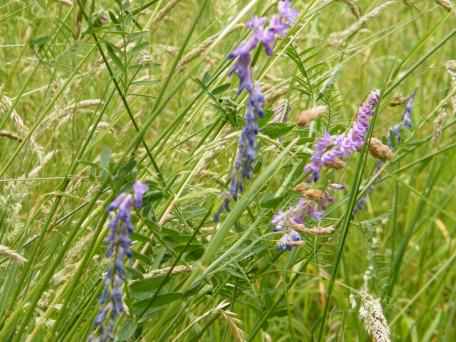

With Willow Leaf beetle?

Photos ©2017–
Click any photo for a larger image
Tufted Vetch - Vicia cracca
Family - Fabaceae
Also known as - Cow vetch, Blue vetch
Tufted Vetch is a fast growing perennial member of the pea and clover family (legumes) native to the UK, Europe and Asia but commonly found elsewhere in the world as an introduced alien species, found in disturbed ground, building sites, woodland edges, roadsides and ditches, growing to a height up to 160cm (63in). . Widespread and common it has a climbing scrambling vine like growth from creeping rhizomes and angular, softly hairy stems. It favours grassy areas, hedgerows, scrub, thickets and field boundaries and is commonly found scrabbling through other vegetation. Pinnate leaves comprise up to twelve pairs of narrow leaflets 5–10mm (0.2–0.4in) long which end in a branched tendril which it uses to climb other plants. The 12–30 leaflets are oblong to linear - lanceolate, the underside is usually hairy.
A conspicuous prolific flowerer with one sided racemes up to 4cm (1.6in) tall of 10–40 bluish purple graduated to pink flowers similar to those of other Pea plants appear June - August, flowers mature to long slender dark brown or black seed pods 2cm (0.8in) long on short stalks contain six to eight seeds. Tufted vetch is pollinated by bees, bumble bees and other large bees.
BCP do not advise or recommend that Tufted Vetch – Vicia cracca is eaten or used as an herbal remedy. Despite being a member of the pea family, the seeds of Tufted Vetch not edible and should not be tasted because they are mildly poisonous.
Also see - Common Vetch.
 |
 With Willow Leaf beetle? |
 |
Photos ©2017– Click any photo for a larger image |
Site design ©1999– Brickfields Country Park - Privacy -